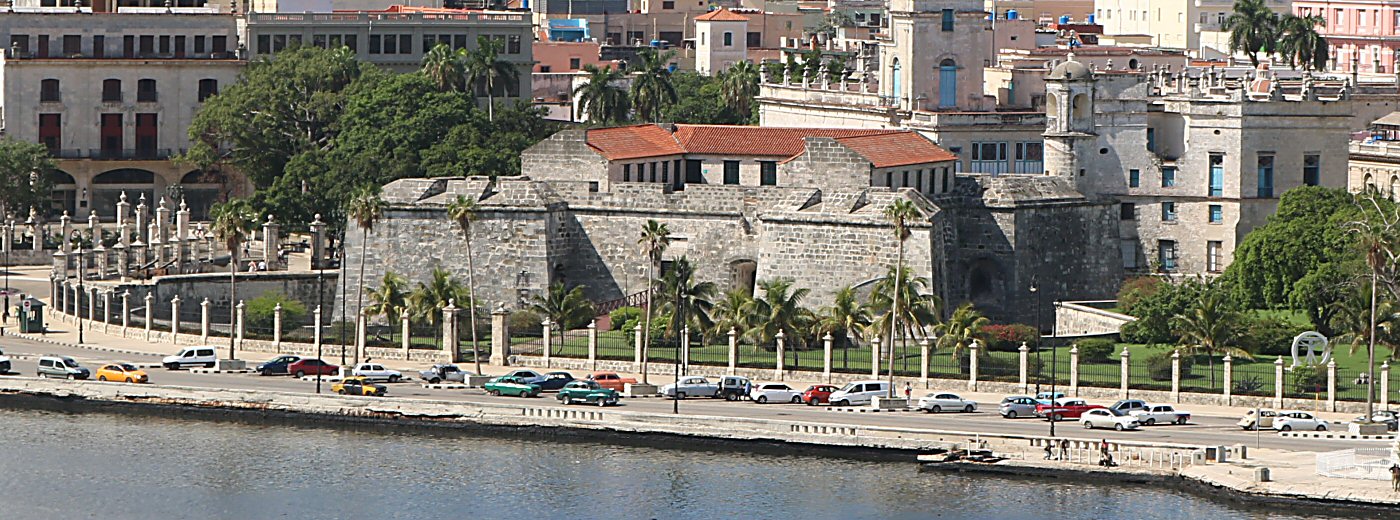
The well-preserved Castillo de la Real
Fuerza, the oldest European defensive stone structure in the
Americas, is also the oldest building in Havana that still
stands today. Meanwhile, it is the first fortress, built to
guard the city and the oldest fortress in Cuba that survived.
Some objects, exhibited in the museum,
are related with the life in the castle. They were found in the
excavations inside of the building. Additionally, during the
tour in the museum, you can learn many details about the history
of the navigation around the island, the history of naval
constructions in Cuba since the 17th century, a sample of
woodworking that were used by native Cubans, and the results of
the investigations of underwater archeology that have been
carried out around Cuba.
HISTORY
After the destruction of the primitive
fort that was the first fort of Havana, known as Fuerza Vieja
(Old Force), by the French corsair Jacques de Sores in 1555, the
King of Spain Philip II (1556-1598) appointed the Spanish
engineer Bartolomé Sánchez to construct a more fortified castle
against the pirates on the site of the former. The construction
of the new fortress, initially known as the Fuerza Nueva,
started at the end of 1558. The new fortress was planned to be
closer to the harbor than the Fuerza Vieja to give a better
strategic position to it. The place was chosen because it was at
the entrance channel of the Bay of Havana. The construction area
occupied a part of the old town square (Plaza de Armas).
Initially, Bartolomé Sánchez had designed a fortress with a huge
tower, but later this has been modified.
Although the ironwork has been completed
in 1558, the construction of the fortress proceeded very slow.
Four years later, Bartolomé Sánchez, the initial director of the
project, was replaced by Francisco de Calona, so that the first
stones could be finally laid in 1562. However, the building
could be completed after 19 years, in 1577, when Philip II
appointed the Spanish admiral Francisco Carreño Governor of
Cuba, replacing Gabriel de Montalvo. Francisco Carreño
immediately noticed the colossal embezzlement of his predecessor
and the architect Francisco de Calona in the construction of the
new fortress. Montalvo was sent chained to Spain, but Francisco
Carreño took pity on the architect, when he saw that the
architect was poor, in debt, and had six children. Even so,
Calona had to reintegrate two thousand ducats into the royal
coffers and to build the cistern of the fortress at his expense.
Calona was able to hide his hatred of the Governor Francisco
Carreño. He sent an exquisite dish to the governor Calona in his
birthday that he envenomed before, so that the governor became
ill and died in a few months.
Initially the French prisoners and the
slaves were providing most of the labor, but later the town
council coerced men in the city into working in the construction
process by making a public announcement. All men of mixed race,
blacks or mulattos that had no owners, had to come and work.
Otherwise, they would receive a penalty of ten pesos or hundred
lashes.
After the inauguration of the fortress
an upper floor was added to the building by the order of the
Governor Francisco Carreño to use the new floor as barracks and
munition store. In 1588 the Governor Juan de Tejeda ordered to
expand the upper floor by addition of the governor’s dwelling.
The governors lived here until 1762. In 1632, a floor was added
to the cylindrical tower on the angle of the southwest bastion,
and the wind vane, the Giraldilla, was placed at the top of this
watchtower in 1634.
The Castillo de la Real Fuerza served
not only as the barracks and the principal defense unit of the
city, but also as the residence of the governor and the captain
general. On the other hand, it was used also to store
temporarily valuable merchandise of the ships that called on
Havana on the way to Spain, such as gold and silver.
In 1851 the facade of the fortress was
demolished to expand the O’Reilly street towards the docks.
During the Ten Years War (1868-1878) it
became the headquarters of the volunteer corps.
In 1899, the US administration moved the
National Archive to the fortress, and it stayed there until
1906. After this date the fortress was used by the Guardia Rural
as barracks. Guardia Rural was a public force, assembled against
Spanish colonialism, but it was against the armed revolution,
conflicting with the mambises.
Between 1938 and 1957 the castle hosted
the National Library. After 1959, the upper floor was used by
the Comisión Nacional de Monumentos, and then by the Centro
Nacional de Conservación, Restauración y Museología, while the
ground floor was allocated to Museo de Armas (Weapons Museum).
In the period of 1990 and 2005 it served as the National Museum
of Ceramics. Currently, all the area inside of the castle is
used by the museum that took the name Museo Castillo de la Real
Fuerza. It was opened after a thorough restoration in 2008. On
the other hand, some continue to call it as Museo de Navegación (Naval
Museum).
Since 1982, it is in World Heritage List
as a part of the Old Havana (Habana Vieja).
